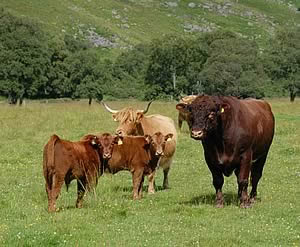 |
|||||||||
|
|||||||||||||||||||
|
|
Organic Beef Production in Scotland Increases The production of finished organic beef and organic grain in Scotland increased during 2008-09 but the production of prime organic lamb is static.
These are just some of the findings of the annual survey of organic producers in Scotland undertaken as part of the SAC Organic Market Link (OML) project. 66% of organic producers took part in the survey which, for the first time, aimed to collect data from all sectors. For the fifth year running more than 90% of Scotland’s beef, lamb and grain producers were accounted for. Between July 2008 and June 2009, organic producers in Scotland will finish just over 8,000 head of organic cattle, (an increase of 17%) and 100,000 prime organic lambs (a reduction of less than 1%). While the number of store cattle has increased by 10% store lamb numbers have fallen once again. This year’s drop of 13% reflects the loss of some hill farmers from the organic sector. On a more encouraging note, the marketing of prime organic lamb will once again be more evenly spread throughout the year, reflecting a great improvement in the marketing pattern. Historically most of the organic lamb was marketed before Christmas leaving shortages until the new season lamb became available. This latest development is great news for the producers, processors, consumers and the environment as it lessens the need for imports of organic lamb. The production of fully organic grains and pulses increased 25% in 2008 to approximately 22,500 tonnes. The survey estimated that 41% of the grains would be retained for on-farm use with the remaining 13,500 tonnes available for trading. With very few, if any, new organic conversions reaching full organic status this coming year, Scotland will not expect any significant increase in new livestock producers. However, when asked about their future intentions (for 2009-2011), 50% of Scotland’s organic prime beef producers said they planned to produce a similar number to this year, whilst a further 43% indicated they intend to increase their organic production. So, similar or slightly higher numbers of prime beef are expected during the next two-year period. Among organic prime lamb producers, more than 60% stated they would produce a similar number to this year, with 19% planning to increase production marginally and a further 5% expecting to expand their numbers significantly. So, once again, in the prime lamb sector during the next couple of years similar or slightly higher numbers to this year’s figures can be expected, as long as the store lambs are still available. According to SAC Organic Market Link Coordinator, Caroline Bayliss, “Information gathered through the OML survey has demonstrated continuity of supply which has given two volume processors the confidence to get their organic beef lines running in Scotland. Supply information is fundamental for processors and multiple retailers when deciding to turn on new market outlets for Scottish organic producers. It has also allowed direct farmer to farmer trading for grains, pulses and store stock to develop. This is useful when the market is small and geographically fragmented. In addition, the results provide pointers to organic producers needing to make production decisions. Once again it is pleasing to see a shift in the seasonal production pattern for lamb. Many producers have obviously made an effort to finish more lamb in late winter/spring to fill this period of supply shortage, something that we have been encouraging them to do for several years. We’re very grateful for the continued co-operation of producers in undertaking the survey."
|
||||||||||||||||||

|
|
||||||||||||||||||
| home | agri-services | pedigree
pen | news | dairy | beef | machinery BPS | property | organisations | site map |
|||||||||||||||||||

